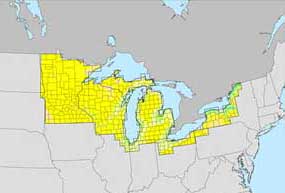|
Current Climate Warm summers, cold winters, and significant amounts of precipitation year-round generally characterise the Great Lakes region. Additionally, the Great Lakes are large enough and close enough to each other to exert significant impacts on local and regional weather. Intense lake-effect snowstorms typically develop on the leeward sides of the lakes. Snow storm totals can often exceed 10 inches. Lake-effect snows are most prominent along the southern and eastern shores of Lake Superior, the eastern shores of Lakes Michigan and Huron, and the southeastern shores of Lakes Erie and Ontario where such snow can account for more than half of the annual snowfall totals. For example, 80 of the 160 inches that usually fall in Traverse City, Michigan typically come from lake-effect. The amount of lake-effect snow that any location gets in any year depends on how much cold air and what the prevailing wind direction is among other factors. During El Niño years, lows move north and/or west of the region, typically bringing less precipitation, fewer cold air outbreaks, and less (lake-effect) snow. (Click here for Great Lakes Regional Summary Report on Current Climate) |
|
Potential Climate
The regional climate through the end of the 21st century will likely be warmer and wetter. The questions of how much warmer and how much wetter may be answered by examining output from two General Circulation Models (GCMs): the Canadian Model (CGCM1) and the United Kingdom Hadley Model -(HadCM2). There is only a slight difference for the period 2025-2034 in summer where the models suggest minimum summer temperatures will increase by 1.8-3.6°F (1-2°C) across the region, while maximum temperatures will increase 0-1.8°F (0-1°C). More warming will occur in the western part of the region than in the eastern part. The net change may be a decrease in the diurnal temperature range in the west and an increase in the east. The decreased diurnal temperature range may suggest slightly more cloudiness or humidity over the western part of the region. Also, summer precipitation may increase by 15-25%. Larger differences exist in winter between the two models. Increases in the minimum temperature of 7.2-10.8°F (4-6°C) from southeast to northwest are projected by the CGCM1 scenario and 0.9-4.5°F (0.5-2.5°C) from east to west by the HadCM2 scenario. Both models suggest more significant changes in mean temperature and precipitation for the period 2090-2099, than for the period 2025-2034. (Click here for Great Lakes Regional Summary Report on Potential Futures —Climate)
Current Population and Economy
Between 1900 and 1930 Flint grew by a factor of 12 to 156,000 people and Detroit grew from less than 300,000 to 1.6 million! Earlier immigrants were from Canada and Europe with very large numbers of Germans going to Wisconsin. The automobile industry brought immigrants from new areas such as Poland, Hungary, Italy and Greece as well as African-Americans from the south. The Great Lakes - St. Lawrence Basin is now home to more than 42 million Americans and Canadians. An estimated 97% of Quebec´s population lives within the St. Lawrence River Basin watershed; two-thirds of its population lives within a 6 mile (10 km) wide strip on either side of the St. Lawrence River. Although there has been dramatic change in the economic structure of the Upper Great Lakes region over the past 200 years, Minnesota still provides about 70% of the iron ore/taconite produced in the US; automobiles are still a very large component of Michigan´s economy dominating the durable goods manufacturing sector; and farming is a $2 billion/yr industry in Wisconsin. The Great Lakes region as a whole is suitable for growing eight of the top ten food crops in the world. Hog production is important in Minnesota, dairy production is important in Wisconsin, and specialty crops are important in Michigan, which ranks first in the US in tart cherry production. (Click here for Regional Summary Report on Overview of Historic and Current Population and Economy in the Great Lakes Region)
Potential Population and Economy
In some sense it is considerably more difficult to imagine what the future socioeconomic situation for the Great Lakes region will be than to consider how the climate itself will change. For example, the auto industry is one of the leading industries in the region, and while its existence is certainly not in jeopardy, its future and exactly how it conducts business will almost certainly be more impacted by the (political) response to climate change than by the climate change itself. The auto industry and climate change are closely — coupled what happens to one affects the other, which makes using separable climate and socioeconomic scenarios somewhat constraining. Other industries are not so much coupled (in a two-way interaction sense) as they are driven (in a one-way forced sense). The electricity industry, for example, is one such industry. What happens politically as a result of climate change will have an impact on this industry (it is responsible for about a third of atmospheric CO2), but climate change itself, with its periods of extreme weather, will also have an impact. A third type of industry, where climate change will have primarily direct impacts is something like recreation. Water levels and frequency of extreme weather are likely to directly impact how many people go to the beaches or go boating for example. (Click here for Regional Summary Report on Overview of Potential Futures of Population and Economy in the Great Lakes Region)

